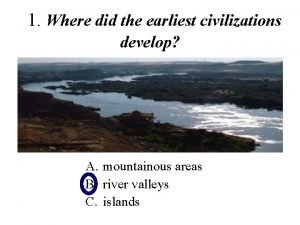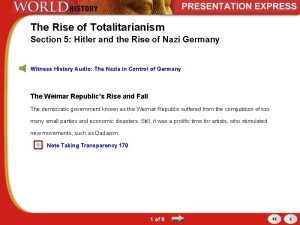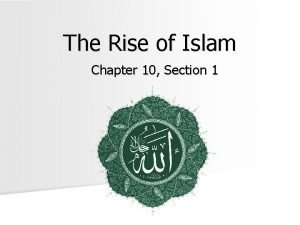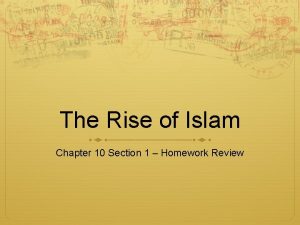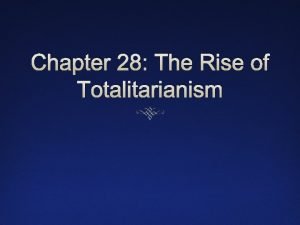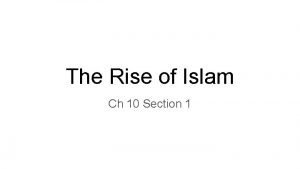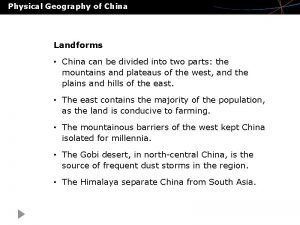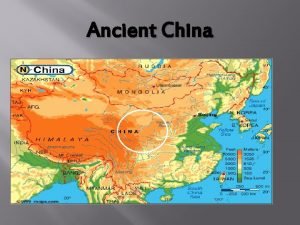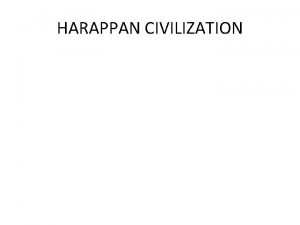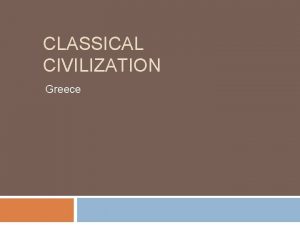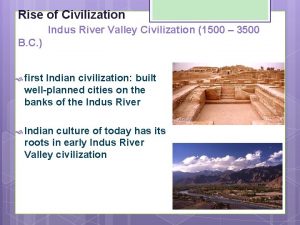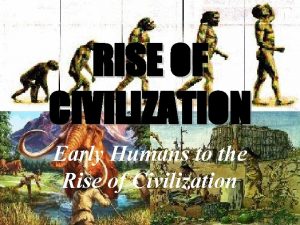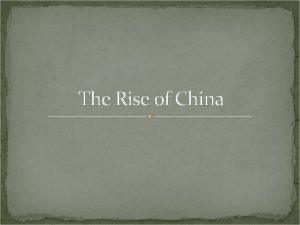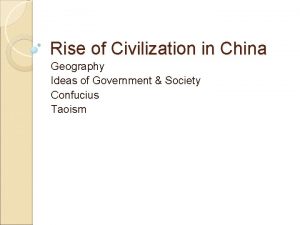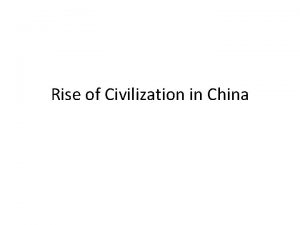Section 4 Rise of Civilization in China Physical

















- Slides: 17

Section 4: Rise of Civilization in China Physical barriers separated China from Egypt, Middle East, and India. This isolation contributed to the Chinese belief that China was the center of the earth and the sole source of civilization. N W E Barriers: • West and Southwest: deserts and high mountain ranges • Southeast: thick rainforests divided China from Southeast Asia • North: Gobi desert • East: Pacific Ocean S

Shang Dynasty • Archaeologists have uncovered some of the large palaces and rich tombs of Shang rulers • Walled capital city, the Shang were able to drive off nomads from the northern steppes and deserts. • Kings probably controlled only a small area; loyal princes and local nobles governed most of the land…. most likely heads of important clans • Top level of Shang society included the royal family and a class of noble warriors; there was a class of artisans and merchants; majority of people were peasants • Warriors used leather armor, bronze weapons, and horse-drawn chariots • Artisans produced goods for nobles: bronze weapons, silk robes, and jade jewelry • Merchants exchanged food and crafts made by local artisans for salt, shells, and other goods not found in northeastern China

• Zhou overthrew the Shang • Justified their attack due to the Mandate of Heaven (divine right to rule); the Zhou felt that the Shang king was so cruel that the gods sent ruin on him. • Zhou rewarded their supporters by granting them control over different regions; therefore, under the Zhou, China developed into a feudal state. • FEUDALISM: system of government in which local lords governed their own lands but owed military service and other forms of support to their ruler • China’s economy grew under the Zhou; started to use money for the first time in China; the strong economy will lead to an increase in population • By 256 B. C. , China was a large, wealthy, and highly developed center of civilization. However, the feudal lords ignored the emperor and battled one another in savage wars …. out of the wars a Zhou Dynasty (joh)

The Dynastic cycle The rise and fall of dynasties

Confucius • Born in 551 B. C. to a noble but poor family • Brilliant scholar, hoped to be an adviser to a local ruler • Unable to find a permanent position within government; he turned to teaching • He attracted many students: Siddhartha Gautama (Buddha) and Socrates (Greece) • Never wrote down his ideas; students collected many of his sayings in the Analects (collection of short literary or philosophical extracts). • Little interest in spiritual matters, instead developed a philosophy (system of ideas) that were concerned with worldly goals, especially

• Taught that harmony resulted when people accepted their place in society • He felt older people were superior to younger ones and men were superior to women • He stressed FIVE key relationships: • Ruler to Subject • Parent to Child • Husband to Wife • Elder Brother to Younger Brother • Friend to Friend • According to Confucius, everyone had duties and responsibilities. • Correct behavior would bring order and stability • Filial Piety: respect for parents; above all other duties

• In the centuries after his death, his ideas influenced many aspects of Chinese life. • Filial piety supported traditional customs such as reverence for ancestors • Introduced the delicate balance between two forces: yin and yang • Hundreds of millions pf people in Korea, Japan, and Vietnam accepted Confucian beliefs

daoism • Laozi (Low tza) “Old Master”: founder of Daosim • Credited with writing The Way of Virtue • Not concerned with bringing order to human affairs; Instead, sought to live in harmony with nature • The Dao = “The Way” • “Those who know the Dao do not speak of it. Those who speak of it do not know it” • To know the Dao, one should reject conflict and strife • Stressed the simple ways of nature and the virtue of yielding. Ex: water, does not resist but rather yields to outside pressure…. yet it is an

Achievements of early china Above: Accurate calendar with 365 ¼ days Right: Silk China’s most valuable export Above: Oracle Bones Right: Calligraphy

Section 5: strong rulers unite china • Qin (chin) Dynasty brought an end to the Zhou Dynasty • Zheng (jeng) crushed all his rivals • In 221 B. C. Zheng proclaimed himself Shi Huangdi (shi whong di) or “First Emperor” • He ushered in China’s classical age – a term historians use when a civilization sets patterns in government, philosophy, religion, science, and the arts that serve as a framework for

Shi Huangdi • Determined to end divisions that had splintered China; he spent 20 years conquering most of the warring states • He centralized power with the help of Legalist advisers: Legalism was based on teachings of Hanfeizi (Hahn fay dzuh) • Hanfeizi insisted that the only way to achieve order was to pass strict laws and impose harsh punishments for crimes • Shi Huangdi tortured, killed, or enslaved many who opposed his rule; the hardest hit were the feudal nobles and Confucian scholars who loathed his laws • He abolished feudalism and replaced the feudal states with 36 military districts and appointed loyal officials to

• He standardized weights and measures and replaced the diverse coins of the Zhou states with Qin coins • Had scholars create uniformity in Chinese writing • Workers repaired and extended roads and canals to strengthen the transportation system • Shi Huangdi’s most remarkable and costly achievement was the Great Wall. • Shi Huangdi died in 210 B. C. ; anger over heavy taxes, forced labor, and cruel policies exploded into revolts. Qin power officially collapsed in 206 B. C. • Gao Zu (gow dzoo) an illiterate peasant leader, defeated rival armies and founded the new Han dynasty four years later

Han Dynasty • Gao Zu (gow zoo) set about restoring order and justice to his empire • He lowered taxes and eased Legalist policies • He appointed Confusion scholars as advisors • His policies created strong foundations for the Han dynasty, which lasted from 202 B. C. until A. D. 220

• Most famous Han emperor • Ruled from about 141 B. C. to 87 B. C. • To train scholars, he set up an imperial university at Xian (shyahn) • Improved canals and roads • He had granaries set up across the empire so the government could buy grain when it was abundant and sell it at stable prices when it was scarce Emperor Wudi • Imposed a government monopoly on iron and salt; Monopoly is the complete control of a product or business by one person or group • Followed the policy of expansionism; expanding a country’s territory, by increasing the amount of land under Chinese rule.

Silk road • Emperor Wudi opened up a network of trade routes, later called the Silk Road, that would link China and the West for centuries • During the Han period, new foods such as grapes, figs, cucumbers, and walnuts flowed into China from western Asia • Chinese sent large quantities of silk westward • Eventually the Silk Road stretched for 4, 000 miles, linking China to the Fertile Crescent in the Middle East.

Achievements of the Han golden age Science and Medicine • • Texts: chemistry, zoology, botany Simple seismograph (earthquakes) Diagnosed diseases, developed anesthetics, herbal remedies Acupuncture: inserts needles into the skin at specific points to relieve pain or treat Technology and Engineering • • • Invented method of making paper out of wood pulp Advanced methods of ship building and invented a rudder to steer Invented bronze and iron stirrups, fishing reels, wheelbarrows, and suspension bridges The Arts • Ban Zhao wrote Lessons for Women a handbook of behavior

Chinese Accept buddhism • By A. D. 400, Buddhism had spread throughout China. Buddhist monasteries became important centers of learning and the arts. Buddhism absorbed many Confucian and
 Sheep become lions
Sheep become lions Tricky dick
Tricky dick Rise again and again until lambs
Rise again and again until lambs A union b example
A union b example The rise of civilization lesson 2 the neolithic revolution
The rise of civilization lesson 2 the neolithic revolution Picture of ancient greece map
Picture of ancient greece map The rise of greek civilization
The rise of greek civilization Where did the earliest civilizations develop
Where did the earliest civilizations develop Symbolic of the rise of physical education in sweden.
Symbolic of the rise of physical education in sweden. The rise of totalitarianism section 5 quiz
The rise of totalitarianism section 5 quiz Chapter 10 section 1 the rise of islam
Chapter 10 section 1 the rise of islam The rise of islam chapter 10 section 1
The rise of islam chapter 10 section 1 The rise of christianity chapter 6 section 3
The rise of christianity chapter 6 section 3 Chapter 28 section 3 fascism in italy
Chapter 28 section 3 fascism in italy Chapter 10 section 1 the rise of islam
Chapter 10 section 1 the rise of islam China physical landforms
China physical landforms Physical map of ancient china
Physical map of ancient china Primitive society physical education
Primitive society physical education







